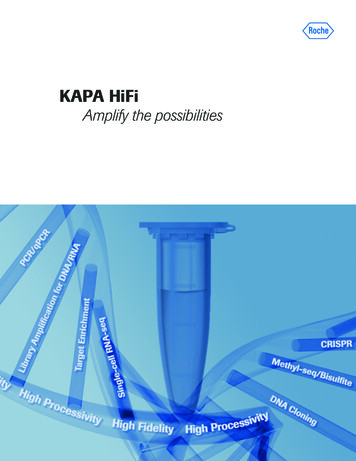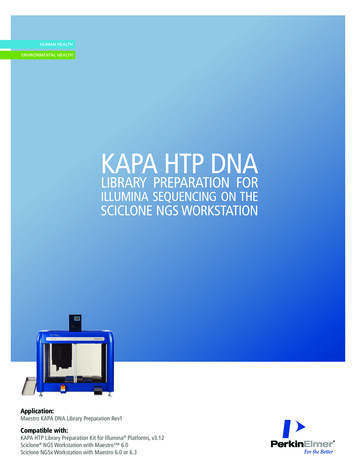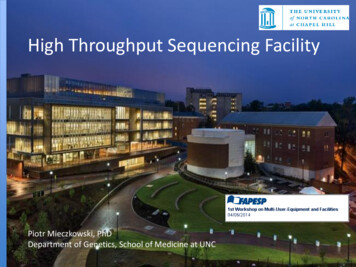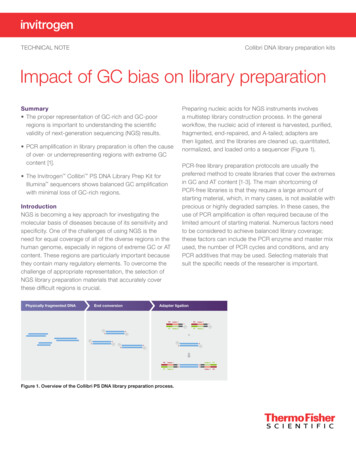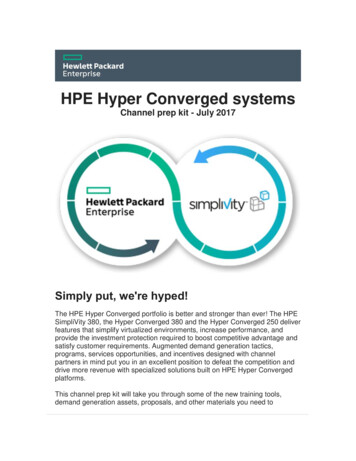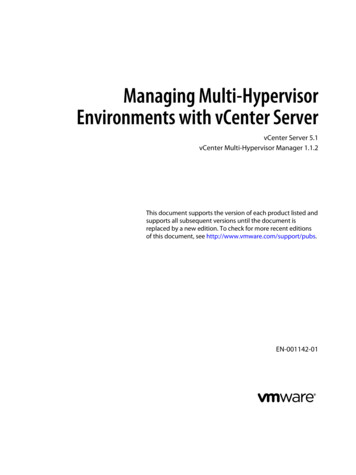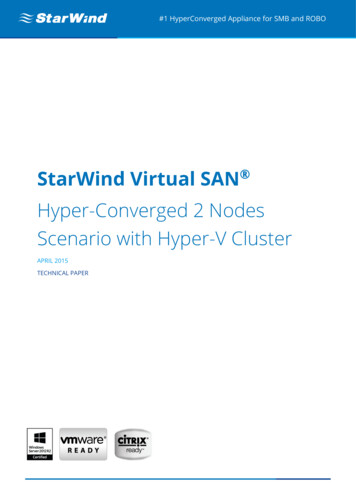
Transcription
Technical Data SheetKAPA Hyper Prep KitIllumina platforms KR0961 – v1.14This Technical Data Sheet provides product informationand a detailed protocol for the KAPA Hyper Prep Kit(Illumina platforms).ContentsProduct Description .2Kit Codes and ComponentsKAPA End Repair & A-Tailing BufferKAPA End Repair & A-Tailing EnzymeKAPA Ligation BufferKAPA DNA LigaseKAPA HiFi HotStart ReadyMixKAPA Library Amplification Primer Mix60 µl25 µl245 µl80 µl250 µl50 µlKAPA End Repair & A-Tailing BufferKAPA End Repair & A-Tailing EnzymeKK8502 KAPA Ligation Buffer24 libraries KAPA DNA LigaseKAPA HiFi HotStart ReadyMixKAPA Library Amplification Primer Mix170 µl72 µl720 µl240 µl690 µl138 µlKAPA End Repair & A-Tailing BufferKAPA End Repair & A-Tailing EnzymeKK8504 KAPA Ligation Buffer96 libraries KAPA DNA LigaseKAPA HiFi HotStart ReadyMixKAPA Library Amplification Primer Mix680 µl290 µl2.88 ml960 µl3 ml600 µlKK85008 librariesProduct Applications .2Product Specifications .2Shipping and storage .2Handling .2Quality control .2Important Parameters .3Safe stopping points .3Paramagnetic SPRI beads and reaction cleanups .3Input DNA and fragmentation .3Adapter design and concentration .3Post-ligation cleanup .4Size selection .4Library amplification .5Evaluating the success of library construction .6Process Workflow .7Library Construction Protocol .8Appendix: Dual-SPRI size selection .10Restrictions and Liabilities .12Note to Purchaser: Limited Product Warranty .12Note to Purchaser: Limited License .12For PCR-free workflows, KK8501 (8 libraries), KK8503 (24 libraries) andKK8505 (96 libraries) are also available. These kits do not include KAPAHiFi HotStart ReadyMix or KAPA Library Amplification Primer Mix.Quick Notes This kit is used for the construction of DNAlibraries for Illumina sequencing in 2 – 3 hours,with minimal hands-on time. The novel one-tube chemistry improves libraryyield and quality for FFPE and low-input libraries. Kits contain KAPA HiFi HotStart ReadyMix andan optimized Library Amplification Primer Mix forhigh-efficiency, low-bias library amplification. Kits without an amplification module are availablefor PCR-free workflows. The process workflow (p. 7) provides an overviewof the library construction process. The appendixprovides protocols for dual-SPRI size selection. Separate, concentrated enzyme formulations andreaction buffers for end repair and A-tailing aswell as ligation provide the best combination ofproduct stability, convenience, and efficiency. Adapters are not supplied with this kit, but canbe obtained from any reputable oligonucleotidevendor. SPRI beads required for post-ligation and postamplification cleanups are not included in the kit.Effective date: April 20141
KAPA Hyper Prep KitIllumina platformsTechnical Data SheetProduct DescriptionProduct ApplicationsThe KAPA Hyper Prep Kit is designed for the rapidconstruction of libraries for Illumina sequencing fromfragmented, double-stranded DNA (dsDNA).The KAPA Hyper Prep Kit is ideally suited for low- andhigh-throughput NGS library construction workflows thatrequire end repair, A-tailing, adapter ligation, and libraryamplification (optional). The protocol may be adaptedfor incorporation into workflows for a wide range of NGSapplications, including:This product is derived from Kapa's existing HTP/LTPLibrary Preparation Kit for Illumina platforms, which wascarefully optimized for the construction of high-qualitylibraries from a wide range of DNA inputs and sampletypes (including FFPE and cell-free DNA), for varioussequencing applications. In the KAPA Hyper Prep Kit, astreamlined protocol is used, combining enzymatic stepsand reducing the number of SPRI bead cleanups, withoutcompromising library yield or quality. The streamlinedprotocol reduces hands-on and overall library preparationtime, and improves consistency by reducing the numberof sample handling steps.The kit contains all of the enzymes and reaction buffersrequired for the following steps of library construction:1. End repair and A-tailing, which produces end-repaired,5'-phosphorylated, 3'-dA-tailed, dsDNA fragments.2. Adapter ligation, during which dsDNA adapters with3'-dTMP overhangs are ligated to 3'-dA-tailed libraryfragments.3. Library amplification (optional), which employs highfidelity, low-bias PCR to amplify library fragmentscarrying appropriate adapter sequences on both ends.The kit provides a single, concentrated buffer and a singleenzyme mixture for each of the two library constructionsteps, but does not include adapters or SPRI beadsrequired for cleanups after adapter ligation and libraryamplification. Kits without amplification reagents(KK8501, KK8503 and KK8505) are available for PCR-freeworkflows.In order to maximize sequence coverage uniformity, itis critical to minimize library amplification bias. KAPAHiFi DNA Polymerase is designed for low-bias, highfidelity PCR, and is the reagent of choice for NGSlibrary amplification.1,2,3,4 The KAPA Hyper Prep Kitincludes KAPA HiFi HotStart ReadyMix (2X), a ready-touse PCR mix comprising all the components for libraryamplification, except primers and template. Kits alsoinclude KAPA Library Amplification Primer Mix, whichis compatible with all libraries prepared with full-lengthIllumina adapters. The kit can be combined with KAPAHiFi Real-Time Library Amplification Kits (KK2701 andKK2702), or with KAPA HiFi HotStart Uracil ReadyMix(KK2801 and KK2802) for the amplification of libraries thathave undergone bisulfite-treatment.1.2.3.4.2Oyola, S.O. et al. BMC Genomics 13, 1 (2012).Quail M.A. et al. Nature Methods 9, 10 (2012).Quail M.A. et al. BMC Genomics 13: 341 (2012).Ross, M.G. et al. Genome Biology 14: R51 (2013). Whole-genome shotgun sequencing Targeted sequencing by solution hybrid selection(i.e. exome or custom capture using the RocheNimblegen , Agilent SureSelect, Illumina TruSeq , orIDT xGen Lockdown Probes systems) ChIP-seq RNA-seq Methyl-seq (in combination with KAPA HiFi HotStartUracil ReadyMix for library amplification)Product SpecificationsShipping and storageThe enzymes provided in this kit are temperature sensitive,and appropriate care should be taken during shipping andstorage. KAPA Hyper Prep Kits are shipped on dry ice orice packs, depending on the destination country. Uponreceipt, immediately store enzymes and reaction buffers at-15 C to -25 C in a constant-temperature freezer. Whenstored under these conditions and handled correctly,the kit components will retain full activity until the expirydate indicated on the kit label.HandlingAlways ensure that components have been fully thawedand thoroughly mixed before use. Keep all enzymecomponents and master mixes on ice as far as possibleduring handling and preparation. KAPA HiFi HotStartReadyMix (2X) may not freeze completely, even whenstored at -15 C to -25 C. Nevertheless, always ensurethat the KAPA HiFi HotStart ReadyMix is fully thawed andthoroughly mixed before use.Quality controlAll kit components are subjected to stringent functionalquality control, are free of detectable contaminating exoand endonuclease activities, and meet strict requirementswith respect to DNA contamination. Please contactsupport@kapabiosystems.com for more information.
KAPA Hyper Prep KitIllumina platformsImportant ParametersLibrary construction workflows must be tailored andoptimized to accommodate specific experimentaldesigns, sample characteristics, sequencing applications,and equipment. The protocol provided in this documentis generic, and reaction parameters may be adjusted asrequired to optimize performance, efficiency, and costeffectiveness. Several critical parameters are discussedin this section.Safe stopping pointsThe library construction process, from end repair andA-tailing to final, amplified library, can be performed in2 – 3 hours, depending on experience and the number ofsamples being processed. If necessary, the protocol maybe paused safely after completion of the post-ligationcleanup (Step 3.17), or prior to the post-amplificationcleanup (Step 4.4).Adapter-ligated library DNA may be stored at 4 C forone week, or at -20 C for at least one month beforeamplification, target enrichment and/or sequencing.To avoid degradation, always store DNA in a bufferedsolution (10 mM Tris-HCl, pH 8.0), and minimize thenumber of freeze-thaw cycles. However, please note thatlibraries constructed for target enrichment must be elutedand stored in PCR-grade water.Paramagnetic SPRI beads and reaction cleanups This protocol has been validated using Agencourt AMPure XP reagent (Beckman Coulter, part numberA63880, A63881, or A63882). Solutions and conditionsfor DNA binding and size selection may differ if otherbeads are used. Observe all the manufacturer's storage and handlingrecommendations for AMPure XP reagent. Beads will settle gradually; always ensure that they arefully resuspended before use. The incubation times provided for reaction cleanupsare guidelines only, and may be modified/optimizedaccording to current protocols, previous experience,and specific equipment and samples in orderto maximize library construction efficiency andthroughput. The time required for complete capture of magneticbeads varies according to the reaction vessel andmagnet used. It is important not to discard or transferany beads with the removal or transfer of supernatant.Capture times should be optimized accordingly. The volumes of 80% ethanol used for bead washesmay be adjusted to accommodate smaller reactionvessels and/or limited pipetting capacity, but it isimportant that the beads are entirely submerged duringthe wash steps. Where possible, use a wash volumethat is equal to the volume of sample plus AMPure XPreagent.Technical Data Sheet It is important to remove all ethanol before proceedingwith subsequent reactions. However, over-drying ofbeads may make them difficult to resuspend, resultingin a dramatic loss of DNA. With optimized pipetting,drying of beads for 3 – 5 min at room temperatureshould be sufficient. Drying of beads at 37 C is notrecommended. Where appropriate, DNA should be eluted from beadsin elution buffer (10 mM Tris-HCl, pH 8.0). Elution ofDNA in PCR-grade water is not recommended, as DNAis unstable in unbuffered solutions. However, librariesconstructed for target enrichment must be eluted andstored in PCR-grade water to allow for drying of DNAprior to target enrichment.Input DNA and fragmentation This protocol has been validated for library constructionfrom 1 ng – 1 µg of appropriately fragmented doublestranded DNA. However, libraries can be preparedfrom lower input amounts if the sample copy numberis sufficient to ensure the requisite coverage andcomplexity in the final library. The above refers to the end repair and A-tailing reactioninput. If input DNA is quantified before fragmentation,and/or fragmented DNA is subjected to cleanup orsize selection prior to end repair, the actual input intolibrary construction may be significantly lower. Thisshould be taken into account when evaluating theefficiency of the process and/or during optimization oflibrary amplification cycle number. Solutions containing high concentrations of EDTA andstrong buffers may negatively affect the end repairand A-tailing reaction, and should be avoided. Iffragmented DNA will not be processed (i.e. subjectedto cleanup or size selection) prior to end repair, DNAshould be fragmented in 10 mM Tris-HCl (pH 8.0 or 8.5)with 0.1 mM EDTA. Fragmentation in water is notrecommended. The proportion of fragmented DNA that is successfullyconverted to adapter-ligated molecules decreasesas input is reduced. When constructing librariesfrom 10 ng fragmented genomic DNA, 5 – 40% ofinput DNA is typically recovered as adapter-ligatedmolecules. Workflows with additional SPRI cleanupsor size selection prior to adapter ligation are likely toresult in a lower yield of adapter-ligated molecules.Adapter design and concentration This protocol has been validated using indexedIllumina TruSeq , Roche Nimblegen SeqCap EZand Agilent SureSelectXT2 adapters, but the kit is alsocompatible with other adapters of similar design. Adapter concentration affects ligation efficiency,as well as adapter and adapter-dimer carry-overthrough the post-ligation cleanup. The optimaladapter concentration for your workflow represents acompromise between cost and the above factors.3
KAPA Hyper Prep KitIllumina platformsTechnical Data SheetAdapter design and concentration (continued)Size selection Ligation efficiency is robust for adapter:insert molarratios ranging from 10:1 to 100:1. Please refer toTable 1 for the recommended adapter concentrationsfor a range of input DNA amounts. If required, any commonly used size selection technique(e.g. dual-SPRI or an electrophoresis-based method)may be integrated in this protocol. High adapter:insert molar ratios ( 100:1) are beneficialfor low-input applications. When optimizing workflowsfor DNA inputs 25 ng, we recommended evaluatingtwo or three adapter concentrations. Try therecommended adapter concentration (Table 1), as wellas one or two additional concentrations in the range of2 – 10 times higher. To accommodate different adapter concentrationswithin a batch of samples processed together, it is bestto vary the concentration of adapter stock solutions,and dispense a fixed volume (5 µl) of each adapter.The alternative – using a single stock solution, anddispensing variable volumes of adapter into ligationreactions – is not recommended.Table 1. Recommended adapter concentrations for librariesconstructed from 1 ng – 1 µg input DNA.Input DNAAdapter stockconcentrationFinal adapterconcentration50 ng – 1 µg15 µM680 nM25 ng7.5 µM340 nM10 ng3 µM136 µM5 ng1.5 µM68 nM2.5 ng750 nM34 nM1 ng300 nM14 nMPost-ligation cleanup It is important to remove excess unligated adapterand adapter-dimers from the library prior to libraryamplification or cluster generation. The KAPA Hyper Prep Kit chemistry reduces adapterdimer formation, and enables efficient elimination ofunused adapter and adapter-dimer with a single postligation cleanup. The optimal SPRI ratio for librariesprepared from fragmented dsDNA with an averagesize in the range of 150 – 350 bp is 0.8X. The volume in which washed beads are resuspendedafter the post-ligation cleanup should be adjusted tosuit your chosen workflow. If proceeding directly tolibrary amplification, determine an appropriate finalvolume in which to elute the library DNA, keeping inmind that you may wish to divert and/or reserve some ofthis library material for archiving and/or QC purposes.Since an optimized 50 µl library amplification reactioncan accommodate a maximum of 20 µl template DNA,an elution volume of 25 µl is recommended.4 Size selection may be carried out at several points inthe overall workflow, for example: prior to end repair of fragmented DNA. after the post-ligation cleanup. after library amplification.The standard KAPA Hyper Prep protocol (pp. 8 – 9)does not include size selection. Please refer to theAppendix for detailed dual-SPRI size selectionprotocols. Size selection inevitably leads to a loss of samplematerial. Depending on the details, these losses canbe dramatic ( 80%), and may significantly increase thenumber of amplification cycles required to generatesufficient material for the next step in the process(capture or sequencing). The potential advantagesof one or more size selection steps in a libraryconstruction workflow should be weighed againstthe potential loss of library complexity, especiallywhen input DNA is limited. A carefully optimizedfragmentation protocol, especially for shorter insertlibraries and/or read lengths, may eliminate the needfor size selection, thereby simplifying the libraryconstruction process and limiting sample losses. Over-amplification of libraries typically results inthe observation of secondary, higher molecularweight peaks when amplified libraries are analyzedelectrophoretically. These higher molecular weightpeaks are artifacts, and typically contain authenticlibrary molecules of the appropriate length. To eliminatethese artifacts, optimization of library amplificationreaction parameters (cycle number and/or primerconcentration), rather than post-amplification sizeselection, is recommended. Please refer to the Libraryamplification subsection for more information. Notethat for some workflows, post-amplification sizeselection may be preferred (e.g. ChIP-seq libraryconstruction). KAPA Ligation Buffer contains high concentrations ofPEG 6000, which will interfere with efficient dual-SPRI size selection and can affect the efficiency of other sizeselection techniques if not removed. If size selectionis performed after ligation, it is important to performat least one SPRI bead cleanup prior to performingbead- or electrophoresis-based size selection.
KAPA Hyper Prep KitIllumina platformsLibrary amplification The enzyme provided in the KAPA HiFi HotStartReadyMix is an antibody-based hot start formulationof KAPA HiFi DNA Polymerase, a novel B-family DNApolymerase engineered for increased processivityand high fidelity. KAPA HiFi HotStart DNA Polymerasehas 5'g3' polymerase and 3'g5' exonuclease(proofreading) activities, but no 5'g3' exonucleaseactivity. The strong 3'g5' exonuclease activity resultsin superior accuracy during DNA amplification. Theerror rate of KAPA HiFi HotStart DNA Polymerase is2.8 x 10-7 errors/base, equivalent to 1 error in 3.5 x 106nucleotides incorporated. In library amplification reactions (set up accordingto the recommended protocol), primers are typicallydepleted before dNTPs. When DNA synthesis canno longer take place due to substrate depletion,subsequent rounds of DNA denaturation andannealing result in the separation of complementaryDNA strands, followed by imperfect annealing tonon-complementary partners. This presumablyresults in the formation of so-called "daisy-chains"or "tangled knots", comprising large assembliesof improperly annealed, partially double-stranded,heteroduplex DNA. These species migrate slowerand are observed as secondary, higher molecularweight peaks during the electrophoretic analysisof amplified libraries. However, they are typicallycomprised of library molecules of the desired length,which are individualized during denaturation prior tocluster amplification or probe hybridization. Sincethese heteroduplexes contain significant portions ofsingle-stranded DNA, over-amplification leads to theunder-quantification of library molecules with assaysemploying dsDNA-binding dyes. qPCR-based libraryquantifications methods, such as the KAPA LibraryQuantification assay, quantify DNA by denaturationand amplification, thereby providing an accuratemeasure of the amount of adapter-ligated moleculesin a library, even if the library was over-amplified.Please refer to the KAPA NGS Library PreparationTechnical Guide for a more detailed discussionof factors that can affect the efficiency of libraryamplification, and the impact of over-amplification onlibrary quantification. KAPA Hyper Prep Kits contain KAPA LibraryAmplification Primer Mix, designed to eliminate or delayprimer depletion during library amplification reactionsperformed with KAPA HiFi HotStart ReadyMix. Theseprimers are based on the P5 and P7 Illumina flowcell sequences, and are suitable for the amplificationof libraries prepared with full-length adapters. Usersupplied primer mixes may be used in combinationwith incomplete or custom adapters. Please contactsupport@kapabiosystems.com for guidelines onthe formulation of user-supplied library amplificationprimers.Technical Data Sheet Excessive library amplification can result in otherunwanted artifacts such as amplification bias, PCRduplicates, chimeric library inserts, and nucleotidesubstitutions. The extent of library amplificationshould therefore be limited as much as possible, whileensuring that sufficient material is generated for QCand downstream processing (e.g. target enrichment orsequencing). If cycled to completion (not recommended) a single50 µl library amplification PCR, performed as describedin Section 4, can produce 8 – 10 µg of amplifiedlibrary. To minimize over-amplification and associatedundesired artifacts, the number of amplification cyclesshould be tailored to produce the optimal amount ofamplified library required for downstream processes.This is typically in the range of 250 ng – 1.5 µg of final,amplified library. Table 2 provides recommended cyclenumbers for libraries prepared from high quality inputDNA to obtain 100 ng or 1 µg of amplified library.Table 2. Recommended cycle numbers to generate 100 ng or1 µg of amplified DNA from 1 ng – 1 µg of input DNA.Input DNA11Number of cycles required to generate:100 ng1 µg1 µg0–12–3500 ng0–13–4250 ng1–34–6100 ng3–46–750 ng4–57–825 ng5–78 – 1010 ng8 – 1111 – 145 ng10 – 1313 – 162.5 ng12 – 1415 – 171 ng14 – 1617 – 19Input into end repair and A-tailing reaction Quantification of adapter-ligated libraries prior toamplification can facilitate optimization, particularlywhen a library construction workflow is firstestablished or optimized. The amount of templateDNA (adapter-ligated molecules) available for libraryamplification may be determined using the KAPALibrary Quantification Kit. Using a simple calculationfor exponential amplification, it is then possible todetermine the number of PCR cycles required toachieve the desired quantity of amplified library. Acalculator for this purpose is available upon requestfrom support@kapabiosystems.com. Refer toTable 3 for the number of cycles recommended toobtain 1 µg of DNA from 0.5 ng – 500 ng of adapterligated DNA. Please note that the actual optimalnumber of amplification cycles may be 1 – 3 cycleshigher or lower, depending on the sample type andsize distribution of the input DNA.5
KAPA Hyper Prep KitIllumina platformsTechnical Data SheetLibrary amplification (continued) Depending on the amount of library material requiredfor your application, it may be possible to omit libraryamplification. In such cases, it is important to ensurethat the adapters used are complete, and will supportsample indexing (where required), cluster amplification,and sequencing. Omitting library amplificationfurther streamlines the workflow and reduces theoverall library preparation time to 2 hours. The highconversion efficiency achievable with the KAPA HyperPrep Kit enables PCR-free workflows from as littleas 100 ng input DNA. KAPA Hyper Prep Kits withoutamplification reagents (KK8501, KK8503 and KK8505)are available for PCR-free workflows.Table 3. Theoretical number of cycles required to obtain 1 µgof amplified library DNA from 0.5 – 500 ng of adapter-ligatedlibrary DNA†.†Adapter-ligatedlibrary DNANumber of cycles requireto generate 1 µg of library DNA500 ng1–2100 ng3–450 ng5–610 ng7–85 ng8–91 ng11 – 12500 pg12 – 13Guidelines are based on library concentrations determined with theqPCR-based KAPA Library Quantification Kit, and amplification withthe KAPA Library Amplification Primer Mix.Evaluating the success of library construction Your specific library construction workflow should betailored and optimized to yield a sufficient amountof adapter-ligated molecules of the desired sizedistribution for the next step in the process (e.g. targetcapture or sequencing), as well as for library QC andarchiving purposes. The size distribution of the final or pre-capturelibrary should be confirmed with an electrophoreticmethod, whereas KAPA Library Quantification Kits forIllumina platforms are recommended for qPCR-basedquantification of libraries. These kits employ primersbased on the Illumina flow cell oligos, and can beused to quantify any libraries that are ready for clusteramplification.6 Once a library construction workflow has beenoptimized, and consistently yields the desired amountof amplified library, it is typically not necessary toperform in-process quality control. However, qPCRbased quantification of libraries after adapter ligationor prior to library amplification can provide usefuldata for optimization or troubleshooting. Accuratequantification of DNA at this stage will allow you toevaluate the efficiency of: the process from end repair to ligation, bydetermining the percentage of input DNA convertedto adapter-ligated molecules. library amplification with the selected number ofcycles, based on the actual amount of templateDNA used in the PCR. The availability of quantification data before and afterlibrary amplification allows the two major phases ofthe library construction process to be evaluated andoptimized independently to achieve the desired yieldof amplified library. If size selection is performed after adapter ligation orlibrary amplification, qPCR quantification before andafter size selection may also be helpful to define therelative benefit of size selection, and to determine theloss of material associated with the process. Electrophoretic evaluation of libraries after adapterligation or before library amplification may beinformative, but remember that unamplified librariesprepared with "forked" adapters will appear to havea larger, wider or bimodal fragment size distributionas compared to the corresponding amplifiedlibraries. The difference in overall appearance andfragment size distribution of an unamplified vs.corresponding, amplified library varies dependingon the electrophoretic system used. To accuratelydetermine the size distribution of an unamplified library,an aliquot of the library may be subjected to one ortwo cycles of amplification (to ensure that adaptersare fully double-stranded) prior to electrophoreticanalysis. Alternatively, useful information may alsobe obtained by electrophoretic analysis of libraryquantification products generated with the KAPALibrary Quantification Kit.
KAPA Hyper Prep KitIllumina platformsTechnical Data SheetProcess WorkflowRecommended QC metricsdsDNA sampleAn optional SPRI bead cleanup (1X – 3X)and/or size selection may be inserted atthis point, and may be required if DNAwas sheared in a volume 50 µl, or in abuffer that is incompatible with end repair.Please refer to Appendix 1 for detailedsize selection protocols.Fragmented dsDNA (50 µl) Concentration and Q-ratio of input DNA(KAPA hgDNA Quantification/QC Kit)for FFPE DNA only Electrophoretic profile of fragmented DNA Actual quantity used for library construction(Qubit /PicoGreen )End Repair and A-Tailing (60 μl)30 min at 20 C30 min at 65 C(Section 1)See Table 1 on p. 4 for recommendedadapter stock concentrations.Adapter ligation (110 μl)15 min at 20 C(Section 2)Post-ligation cleanup (198 μl)0.8X SPRI Size selection, employing SPRI beadsor an electrophoretic method, may beincorporated at this point, if appropriate.PCR-free workflows end here.(Section 3) Concentration of adapter-ligated libraries(KAPA Library Quantification Kit)*Library amplification (50 μl)*Adapter-ligated libraries diluted in the range of 1/500 to1/5,000 usually fall within the dynamic range of the assay.(Section 4)Post-amplificationcleanup (100 μl)1X SPRI (Section 5)Size selection, employing SPRI beadsor an electrophoretic method, may beincorporated at this point, if appropriate. Electrophoretic profile of amplified libraries Concentration of amplified libraries(KAPA Library Quantification Kit)*Target capture or Sequencing*Amplified libraries diluted in the range of 1/10,00 to1/100,000 usually fall within the dynamic range of the assay.7
KAPA Hyper Prep KitIllumina platformsTechnical Data SheetLibrary Construction Protocol3.Post-ligation CleanupNote: This protocol does not include size selection.Please refer to the Appendix for detailed dual-SPRI sizeselection protocols.3.1Perform a 0.8X SPRI cleanup by combining thefollowing:1.End Repair and A-Tailing1.1Assemble each End Repair & A-Tailing reaction asfollows in a tube or well of a PCR plate:ComponentVolumeFragmented, double-stranded DNA50 µlEnd Repair & A-Tailing Buffer†7 µlEnd Repair & A-Tailing Enzyme MixTotal volume60 µlThe buffer and enzyme mix may be pre-mixed and added in a singlepipetting step. Premixes are stable for 24 hours at room temperature,for 1 week at 4 C, and for 3 months at -20 C.1.2Mix thoroughly and centrifuge briefly.1.3Incubate in a thermocycler with the followingthermal profile:StepEnd Repair & A-TailingHOLDTempTime20 C30 min65 C30 min4 C Proceed immediately to the next step.2.Adapter Ligation2.1Dilute adapter stocks to the appropriateconcentration, as outlined in Table 1 on p. 4.2.2Assemble each Adapter Ligation reaction asfollows:VolumeEnd Repair & A-Tailing reaction productPCR-grade water†60 µl5 µlLigation Buffer†30 µlDNA Ligase10 µl†Adapter stockTotal volume†5 µl110 µlThe water, buffer and ligase enzyme may be premixed and addedin a single pipetting step. Premixes are stable for 24 hours at roomtemperature, for 1 week at 4 C, and for 3 months at -20 C.2.2Mix thoroughly and centrifuge briefly.2.3Incubate at 20 C for 15 min.2.4Proceed immediately to the next step.8110 µlAgencourt AMPure XP reagent88 µl Total volume198 µl3.2Thorough
is critical to minimize library amplification bias. KAPA HiFi DNA Polymerase is designed for low-bias, high-fidelity PCR, and is the reagent of choice for NGS library amplification.1,2,3,4 The KAPA Hyper Prep Kit includes KAPA HiFi HotStart ReadyMix (2X), a ready-to-use PCR mix comprising all the components for library

